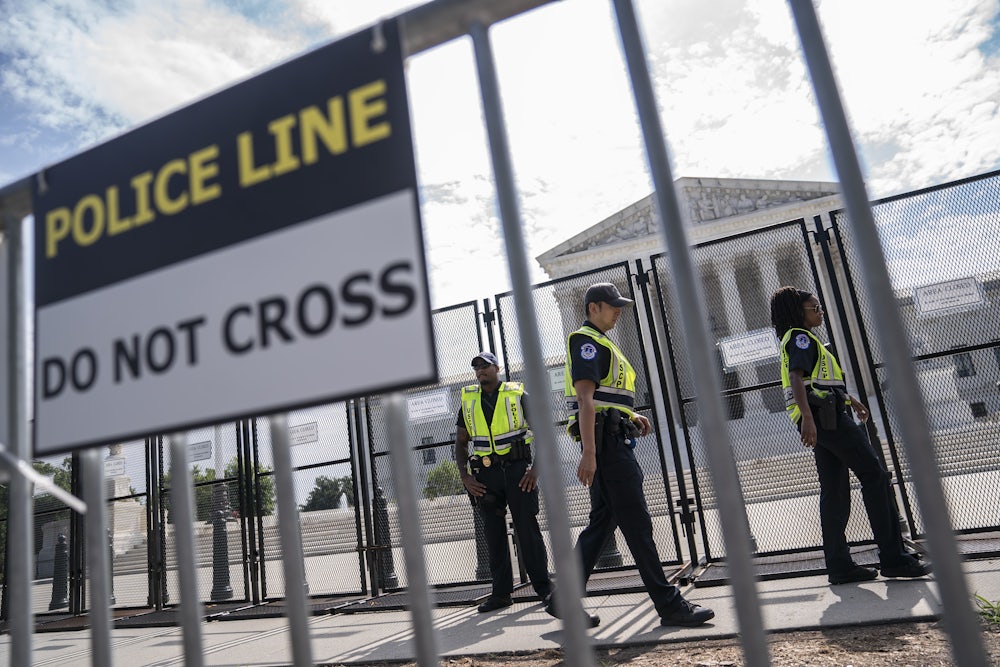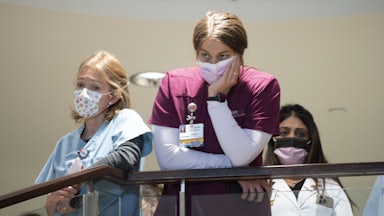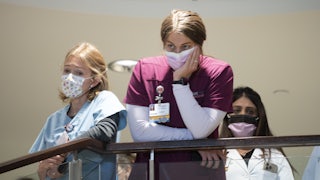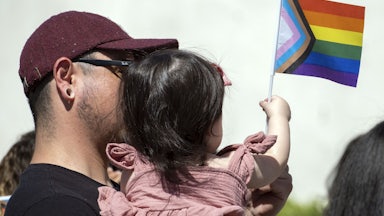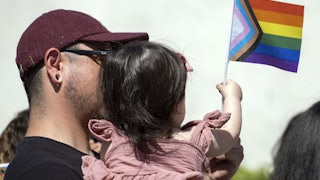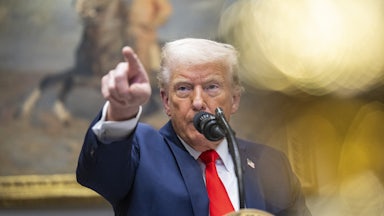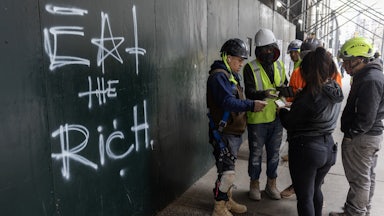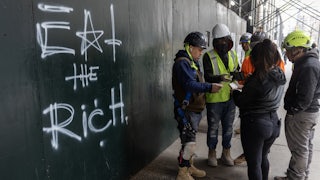The House of Representatives voted on Tuesday to extend security protections to the immediate family members of Supreme Court justices, sending the measure to President Joe Biden’s desk for his signature. House Democrats passed the measure after stripping out a provision that would have also protected the justices’ clerks, after Senate Minority Leader Mitch McConnell said a version with language to this effect would stand no chance in the Senate. The White House’s press office has indicated that the president will sign this bill into law at his earliest opportunity. It’s about time.
I’ll come back to the dispute over the justices’ clerks—and what it says about where the two parties stand on political violence—in a minute. It’s worth taking stock first of what may be the end of an era for the Supreme Court, one when the justices could live relatively unencumbered and semi-anonymous lives compared to other high-ranking government officials. The court has been fairly lucky so far when it comes to security threats. Unfortunately, luck may no longer be enough.
The court does not share details about the justices’ past or present security arrangements for obvious reasons. Some of the general measures used to protect them are not secret. The Supreme Court building in Washington, D.C., which is located across the street from the Capitol, has its own independent police force to protect it. The U.S. Marshals Service also generally provides security for federal judges and other federal courthouses. More recently, the governors of Maryland and Virginia have provided additional police details to the justices who live in those states. Those security measures were often minimal or nonexistent throughout the Supreme Court’s history, until very recently—a strange absence given the justices’ supreme role in the American political system.
Why the lax approach? For one, no Supreme Court justice has ever been assassinated or injured in an assassination attempt, sparing the court from tragedies that have struck the executive branch, Congress, and the lower federal courts. (Three federal judges were assassinated in the twentieth century; a fourth, John Roll, died as a bystander when a gunman attempted to assassinate former Arizona Representative Gabby Giffords in 2011.) Lawmakers are usually more reactive than proactive when it comes to these things: The Secret Service did not officially protect presidents until after the third successful assassination, of William McKinley in 1901, and did not include presidential candidates until after Robert F. Kennedy was killed in 1968.
Before the arrest of a California man outside Justice Brett Kavanaugh’s home last week, I know of no other modern instance where someone was charged with attempting to kill a Supreme Court justice. In a 2012 article on the justices’ previously low security, The New York Times noted that the most recent episode of targeted violence against a justice was when an anti-pornography and anti-desegregation activist punched Byron White in Utah in 1982. But security concerns have never been far from the court’s mind. Harry Blackmun, the author of Roe v. Wade, used to tell strangers that he simply “worked for the government.” And in debates over televising the court’s oral argument sessions, some observers have suggested that the justices are reluctant to make themselves more personally recognizable to the average American.
It may seem strange to describe nine of the most powerful people in this country as anonymous, but in a practical sense, they often are. A C-SPAN poll from earlier this year found that only about half of Americans could identify any Supreme Court justice by name; only 25 percent of them could name Justice Clarence Thomas, who replaced Ruth Bader Ginsburg as the court’s most relatively recognizable member after Ginsburg’s death in 2020. About 7 percent of Americans could name Justices Samuel Alito and Neil Gorsuch, who received the lowest numbers. These figures have nevertheless ticked up from past C-SPAN surveys. For most of his tenure, for example, Alito could only be named by between 1 and 3 percent of those surveyed. Thomas’s number also nearly doubled from the last survey in 2018.
I have not yet personally run into any of the justices since I moved to D.C. almost a decade ago, but I occasionally used to hear friends tell me that they spotted one of them at a bookstore or supermarket, almost always unrecognized by anyone else around them. Until her death, Ruth Bader Ginsburg lived in an apartment at the Watergate complex—yes, that Watergate complex—in the Foggy Bottom neighborhood. When I worked at The Atlantic, which had office space in one of the adjacent buildings, my co-workers would sometimes see her buying things at the CVS store in the center of the complex. I never thought to ask them if she had a security detail with her, but I often saw her accompanied by one when she attended scheduled events.
Since the justices blend into the background so easily, they have not been immune to more pedestrian forms of crime. Ginsburg herself was accosted by a purse snatcher in 1996 near her Watergate home. In 2004, a group of youths attacked then-Justice David Souter while he was jogging in southwestern Washington. Justice Stephen Breyer went through two robbery-related incidents in 2012: one in which a burglar broke into his Washington home and another at his Caribbean vacation home, where an intruder wielding a machete stole about $1,000 in cash while he was there with family and friends. None of these incidents appeared to be related to their work.
It’s worth noting that federal judges who work in the lower courts have suffered even more greatly in targeted attacks. Judge Joan Lefkow, who served on the federal district court for Chicago, came home one day in 2005 to discover someone had murdered her husband and her mother. Law enforcement scrutiny initially fell on a white-supremacist group that had plotted against Lefkow before for a ruling she had handed down against its leader. A few days later, an unemployed electrician who often filed bogus and vexatious lawsuits admitted in a suicide note that he had killed Lefkow’s family.
More recently, a gunman shot and killed Judge Esther Salas’s son and wounded her husband in an attack on her home in New Jersey in 2020. The gunman, a racist and misogynistic lawyer who had a history of filing frivolous lawsuits, died by suicide in upstate New York shortly thereafter. Police identified him as the primary suspect in the attack, citing his long history of bigoted complaints against Salas. In the wake of the tragedy, Salas became an advocate for stronger security protections for judges and their families. New Jersey passed a law that makes it illegal to share a judge’s personal information—their home address, most notably—on the internet.
Similar measures might soon be considered at the federal level after a wave of abortion rights protests outside the justices’ homes over the past few weeks. Though these were nonviolent in nature, conservatives have painted them as an effort to intimidate the justices, especially after Alito’s draft opinion in Dobbs v. Jackson Women’s Health Organization leaked to Politico last month. Some of the more belligerent figures on the right, such as Florida Governor Ron DeSantis, drew nonsensical comparisons to the January 6, 2021, insurrection. That wasn’t so much about descriptive accuracy as being inflammatory toward liberal protesters—and exculpatory toward coup plotters.
That brings us back to the clerks who ended up getting excluded from this bill’s proposed protections. After Alito’s draft opinion leaked, a few right-wing commentators took to social media to try to identify which clerk may have been responsible. They shared names and photographs of certain clerks who they thought seemed most likely to have done it. (For obvious reasons, I’m not linking to it or spreading it further.) Knowing how things work on the internet these days, it would be surprising if those “identified” by the commentators didn’t receive threats for their unproven role in the leak.
House Democrats tried to expand the Senate-approved bill this week to include clerks in the new security protections. That seems fairly reasonable, given the intense backlash that that person may receive from some corners of American politics if they are ever publicly identified. McConnell said no. “The security issue is related to the Supreme Court justices, not to nameless staff that no one knows,” he told reporters on Capitol Hill on Monday. Democrats quickly folded and stripped that language out of the version that passed on Tuesday. In effect, Congress is just hoping that the clerks will get lucky if something happens to them.
I’ve written before on how the United States has been lucky—not in the sense that we’ve been fortunate but in the sense that we’ve somehow avoided much worse outcomes—when it comes to political violence in recent years. We’ve been lucky that no member of Congress has been killed in office in more than 40 years, despite multiple near-fatal attempts, including the Giffords assassination attempt, the 2017 shooting at a Republican congressional baseball practice session, and the January 6 riot itself. We’ve also been lucky that federal agents have disrupted or prevented multiple assassination-spree plots before they could claim any lives. For many years, luck was enough to keep the Supreme Court justices safe. Now it isn’t. That is a grim benchmark of the state of political violence in this country. Hopefully it will be one that isn’t surpassed.
